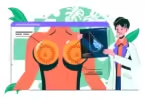Being a woman comes with unique problems and considerations that men will never have to worry about. One such problem is uterine fibroids, which are growths of the tissue that line the uterus. Fibroids are benign, meaning they are not cancerous but can cause significant pain and discomfort. In some cases, they can also lead to problems with fertility.
There are several treatment options for uterine fibroids, but one of the most effective is uterine fibroid embolization (UFE). This minimally-invasive procedure involves cutting off the blood supply to the fibroids, causing them to shrink.
UFE is usually performed on an outpatient basis, meaning you won’t have to stay in the hospital overnight.
Uterine fibroid embolization has several advantages over other treatments, as explained below.
It Is Less Invasive
UFE is a minimally-invasive procedure, which means it involves less risk than other treatments for uterine fibroids. Most women with UFE can go home the same day as their procedure.
The procedure involves making a small incision in the groin area to insert a catheter into the uterine artery. Once the catheter is in place, a contrast agent is injected so that the blood vessels can be seen on X-ray. Then, tiny particles are injected into the arteries that supply blood to the fibroids. These particles block the blood flow, causing the fibroids to shrink.
It Is Effective
UFE is a highly effective treatment for uterine fibroids. It is worth noting that UFE is not a cure for uterine fibroids. However, it can provide significant relief from the symptoms associated with the condition. To date, thousands of UFE procedures have been performed worldwide with an excellent safety record. It is always advisable to consult an expert interventional radiologist for the best results.
It Has a Short Recovery Time
As UFE is a minimally-invasive procedure, the recovery time is relatively short. Most women undergoing the procedure can return to normal activities within a week. This is unlike other treatments for uterine fibroids, such as surgery, which can require a lengthy recovery period.
It Is Safe
UFE is a safe procedure with a low risk of complications. The complication rate is less than 1%. The most common complications associated with UFE are bruising and soreness in the groin area, but these are typically mild and should resolve a few days after the procedure.
This is unlike other treatments for uterine fibroids, such as surgery, which carry a higher risk of complications like infection, blood loss, and damage to the surrounding organs.

It Preserves Fertility
UFE is an effective treatment for uterine fibroids without impacting a woman’s fertility. The treatment does this by preserving the ovaries and the uterus. This is unlike other treatments, such as surgery, which can damage the uterus and surrounding organs, potentially impacting a woman’s ability to conceive.
It Preserves the Uterus
UFE is a uterine-sparing procedure, meaning it preserves the uterus. This is important for women who want to maintain their reproductive organs and fertility. It does this by cutting off the blood supply to the fibroids without damaging the surrounding tissue. It is also worth noting that UFE can be repeated if necessary. The procedure can be safely performed more than once if fibroids return or grow after the initial treatment.
It Is an Alternative to a Hysterectomy
UFE is an alternative to hysterectomy, which is the surgical removal of the uterus. This is a major surgery that comes with several risks and side effects. UFE can provide the same symptomatic relief as a hysterectomy without the need for surgery.
It May Be Covered by Insurance
Uterine fibroid embolization is often covered by insurance. Most companies will cover the procedure if it is considered medically necessary. This is unlike other treatments for uterine fibroids, such as surgery, which can be quite costly and not covered by insurance companies. If considering UFE, check with your insurance provider to see if the procedure is covered.
It Is an Option for Women Who Cannot Take Hormone Therapy
Hormone therapy is often used to treat uterine fibroids. However, this treatment is not an option for all women. Hormone therapy can have serious side effects, such as weight gain, mood swings, and headaches. Additionally, hormone therapy can also increase the risk of certain types of cancer.
For these reasons, UFE may be a better option for women who cannot take hormone therapy. This is because the procedure does not rely on hormones to shrink the fibroids.
It May Be an Option for Women Who Have Not Responded to Other Treatments
UFE may be an option for women who have not responded to other treatments like hormone therapy or surgery. This is because the procedure can be effective in treating even the most difficult to treat fibroids. If you have tried other treatments without success, UFE may be worth considering.
It Improves the Symptoms of Uterine Fibroids
UFE can improve the symptoms of uterine fibroids, such as heavy bleeding, pain, and pressure. The procedure shrinks the fibroids, which relieves the symptoms. Many women find that their symptoms resolve completely after UFE. Other women may find that their symptoms are greatly improved.
It Can Treat Multiple Fibroids
Sometimes, women can have multiple fibroids. This can be due to genetic factors or other underlying conditions. UFE can be used to treat multiple fibroids simultaneously. This is unlike surgery, which would require multiple procedures to remove each fibroid.
It Expulses Fibroids
UFE expulses the fibroids from the uterus. This differs from other treatments, such as surgery and removing fibroids. UFE expels the fibroids, which means they are no longer in the uterus. This can provide significant relief from symptoms and may reduce the risk of recurrence.
Conclusion
If you are suffering from uterine fibroids, UFE may be a treatment option worth considering. The procedure is minimally invasive, has a high success rate, and can provide significant relief from symptoms. Be sure to discuss UFE with your doctor to see if it is right for you. Also, check with your insurance provider to see if the procedure is covered.
AUTHOR’S BIO:
Tracie Johnson is a New Jersey native and an alum of Penn State University. Tracie is passionate about writing, reading, and living a healthy lifestyle. She feels happiest when around a campfire surrounded by friends, family, and her Dachshund named Rufus. If you looking for information regarding Uterine Fibroid Treatment in Memphis TN, Tracie recommends Vascular Interventional Physicians.








